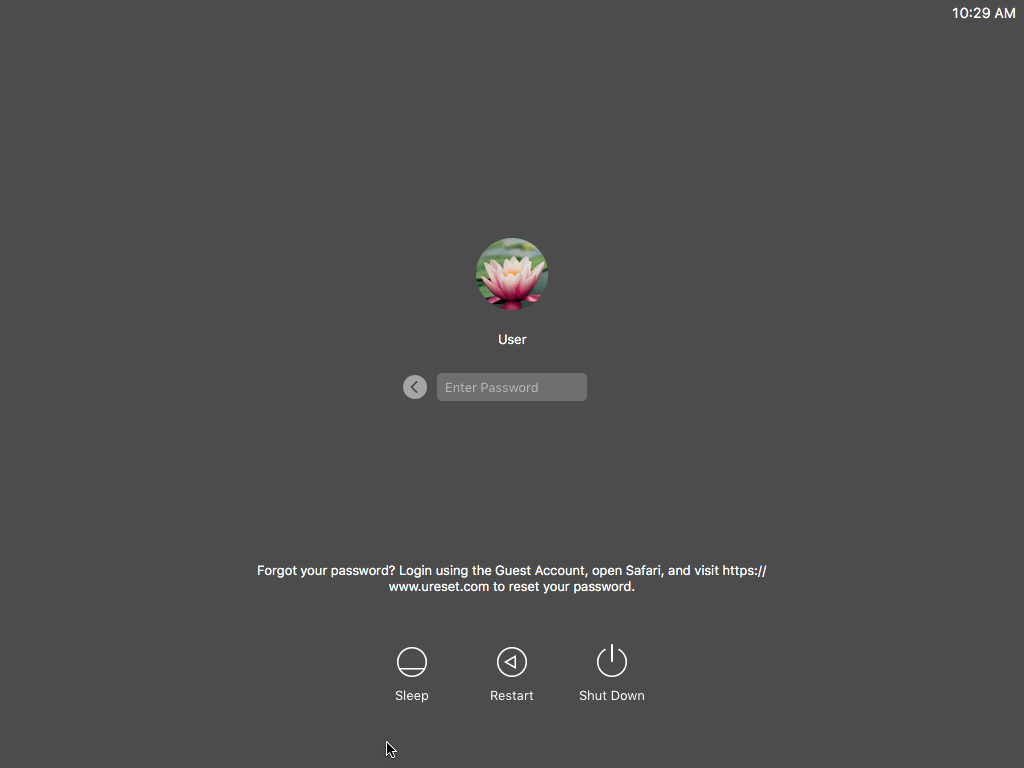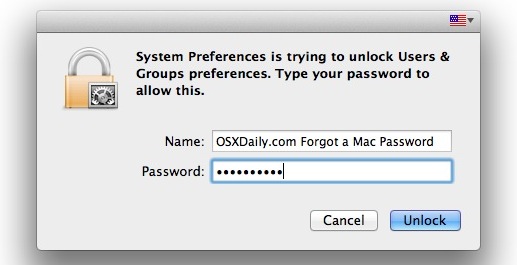And at that time Mac user are unable to access anything of laptop.But at that condition you can reset your Mac User Password.Yess!! It is possible by following some simple steps. In this post i will tell you the method to reset forgotten Mac User Password Without any boot drive or cd in recovery mode.The best thing of this trick is that it. Reset password with Apple ID If you have an Apple ID tied to your user account on Mac, you can use it to reset password from the login window. The option should be available by default. Otherwise, you can enable it in System Preferences Users & Groups Allows user to reset password using Apple ID.
May 07, 2015 Reset Mac password without OS disc and without losing data: Tutorial for Mac versions 10.6 or lower: 1. Boot into single user mode (press Command-S at power on) 2. Aug 13, 2019 From macOS Recovery, you can access a hidden a password reset tool and use it to change any user account’s password on the Mac. Now that there are SecureToken users, the command below no longer works to reset another user's password. Thanks to mario on the MacAdmins Slack for testing. Just a cleaned-up version of directions from Mac Script to change Administrator password. Changing a user password via terminal command. Method #3: Use Recovery Mode to Recover Mac Password. Besides providing all the essential luster to the fundamentals of the operating system, Apple provides a tool, that is “Recovery Mode” for Mac OS or Mac OS X, depending upon which version you are currently using, you can use it to recover your forgotten Mac login or admin password.
| Click here to return to the '10.5: Reset a user's password in single user mode' hint |
http://docs.info.apple.com/article.html?artnum=306840
..which has you first delete, then change, the old password.
Hmmm this article does only delete a part of a user's record, the AuthAuthority value, in fact. This article is useful if you have a user created in 10.2.x and migrated in 10.5.
Beginning with 10.3, Apple changed the way passwords are stored for more security. Before 10.3, passwords were stored in the NetInfo database, in the users entries, using the unsecure crypt hash. Starting with 10.3, passwords are using stronger hashes (SHA-1 and beginning with 10.4 a Salted-SHA1) and they are no longer stored in the users entries but in /private/var/db/shadow/hash, in a file which is named with each user's GeneratedUID (not the old unix UID, be careful). This folder is only accessible to root and the AuthAuthority attribute tells the system which kind of password you have.
So, if your user was created before 10.3 and you have migrated it, you may want to do what this KB article explains.
The dscl command portion of this hint will work in 10.4 - I just used it to remotely reset admin passwords on several machines via ARD.
Thanks!!!
---
0
Once you mount the file system, can't you just use passwd <username> ?
Of course neither method will change the user's login keychain password.
passwd will change the user's password in whatever way the system has been set up. Unix systems don't all use /etc/passwd, actually most standalone systems use /etc/shadow not /etc/passwd. Most networked systems use ldap or kerberos or even opendirectory. If passwd has been tailored correctly to the mac it should change the user's password correctly. Maybe not the keychain access password though.
N.B. I haven't tried using passwd in 10.5.
I did just the following after rebooting to single user mode in 10.5 and it worked:
After the next reboot my machine didn't automatically login, even though it is configured to do so, and it prompted me for the keychain password in order join my wireless network, but it did honor the new password and it sounds like you can subsequently reset the password in System Preferences to change the keychain password.You don't have to worry about the Keychain password. Once you change the user's password and can log into the computer all need to do is simply go into the Accounts preference pane and change the password there to either the new password or something different if you so choose. That action will then automatically change the Keychain Password. I've done this several hundred times on Macs from 10.0 through 10.4.11 I haven't yet had to change a password on a Leopard box but I'm sure it will work just the same.
---
Tino XIII
Unfortunately, this doesn't seem to work with 10.5. I just did this and now can't access the login keychain (OS 10.5.6). Unfortunately, I don't think there's any way around this.
Aside from Open Firmware/EFI passwords, you can configure your Mac so that the root password must be entered in order to access Single User Mode. If your root account is disabled, then it is impossible to enter the root password, and Single User Mode cannot be started.
To do this, the console and ttys must be marked as insecure in /etc/ttys:
1. Log in as administrator
2. Open Terminal
3. cd /etc
4. sudo cp ttys ttys.old (backs up previous ttys config).
5. sudo pico ttys
6. Replace all occurrences of the word 'secure' with 'insecure' at any lines that do not begin with a '#'
7. Exit, saving changes.
These instructions are from the Apple Mac OS X Security Configuration manual.
This procedure works except that the password for login.keychain remains lost. What will reset that? Thanks!
In case you want to, you can set up your Mac to allow login without entering password. This way you can start working right away on your Mac at any time without having to login every time with a password.
Login to Mac Without Entering Password
While it is possible to configure a Mac to allow direct access without asking for a login password, you need to be aware that this setting is not recommended in case you have confidential files or data on your Mac.

However, configuring a Mac to allow automatic access without entering a login password can be helpful in the following situations
1. You have a Common Mac that is used by all the members of your house.
2. You are living alone and want the convenience of using your Mac right away, without going through the login process.
3. You have a Mac that is primarily meant to be used by your Kids.
Mac Password Not Working

4. Your Mac is mostly located in your house and it does not really matter even if someone in your house gets access to your files.
In all such cases, you may be right in setting up your Mac to just turn on and allow immediate access, without having to log into it all the time.
Setup Mac to login Without Entering Password
1. Click on the Apple logo in the top menu bar on your Mac and then click on System Preferences… in the drop-down menu.
2. On the System Preferences screen, click on Users & Groups option.
3. On the next screen (Users & Group), click on the Lock icon located at the bottom left corner of the window.
4. Next, enter your Admin Name and Password when prompted and then click on the blue Unlock button.
5. Next click on the Login Options button, located at the lower left corner of the Users & Groups window.

6. Next, click inside the Automatic Login option box and then select the User Account that you want your Mac to allow Automatic login when it powers on (See image below)
7. Whenever you are prompted, enter the password for the Account that you have selected for Automatic login and click on the OK button.
8. Next, take a look at Automatic Login entry on the Users & Group screen, it should indicate the name of the Account that you had configured or allowed to login Automatically on your Mac (See image below)

Although the Automatic login feature allows you to Login Automatically when your Mac powers on, it will not log you in Automatically again if you logout of your User Account or switch to a different User Account.
This means that every time you Logout of your User Account or switch to a Different User Account, you will be required to enter your Login Password. The other option in such a case is to reboot your Mac and it will once again allow you to Login Automatically, without entering a password.
In Case Automatic Login is Not Working
Guest User Mac Password
If you are having trouble setting up automatic login on your Mac, it is likely that you have the FileVault option enabled for that account or that particular account has been setup to login with an iCloud Account.
The solution in this case is to turn off FileVault by accessing System Preferences > Security & Privacy > FileVault.
Macbook Password Issues
If the account has been setup to login with an iCloud Account, you can change the account to login with a Manual Password by accessing System Preferences > Users & Groups > Change Password.
Mac Mini Password
After making the changes as applicable in your case, you should have no problem setting up your Mac to allow you to login without entering password.